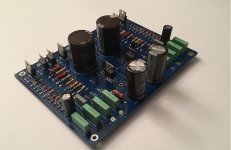I am trying to generate about 350V from 420V unregulated - about 50ma. The regulation for this design is not the best - I was wondering if it could be improved or other ideas welcome.

My take on it.
Sim by Rongon.
"I used a Bob Cordell model for the TL783.
It looks fine. Really fine, actually.
With a 50mA load, 400V in, 350V out, the TL783 dissipates 845mW.
Ripple reduction (120Hz) is -110dB."

Sim by Rongon.
"I used a Bob Cordell model for the TL783.
It looks fine. Really fine, actually.
With a 50mA load, 400V in, 350V out, the TL783 dissipates 845mW.
Ripple reduction (120Hz) is -110dB."
Try simulate this
And you can ad a capacity multiplier before the regulator.
At your schematic you need/can ad a input/sieve capacitor of 100uf/450v.

And you can ad a capacity multiplier before the regulator.
At your schematic you need/can ad a input/sieve capacitor of 100uf/450v.
Last edited:
I'll be trying this one w/ larger darlington for more current- very simple
https://www.nutsvolts.com/magazine/article/a-semiconductor-based-high-voltage-utility-power-supply
https://www.nutsvolts.com/magazine/article/a-semiconductor-based-high-voltage-utility-power-supply
I am liking the TL783 it needs a zener to protect it so no current limit but I don't think that's an issue. From #8 wonder if you can do something clever with the TL431. Avoiding large voltage zeners as the temperature coefficient is large.
I misread the original schematic. At first glance I assumed TL431 was being used as part of the diff-amp, not the reference for it. I would think a different circuit using the TL431 as both diff amp and reference would be superior.
OK I gave this a go based on #8. Even simpler. Works in simulation but oscillated (a good sign of regulation)! Added C11 which seems to solve that. However, it is something I need to prototype.

Some ideas:
These are probably overkill:
https://www.diyaudio.com/community/threads/a-commodity-based-hv-regulator-flexhv.344887/post-5966123
https://www.diyaudio.com/community/...istors-for-450v-reference.242624/post-5962982
These are simpler:
https://www.diyaudio.com/community/threads/simple-hv-series-regulators.198986/post-2753552
A negative one, but if the input is floating, it doesn't matter:
https://www.diyaudio.com/community/...voltage-regulator-circuit.180140/post-2417349
They have the advantadge of being referenced to a single rail, which limits the risks of failure and only require low-voltage parts. The ballast transistor is the only HV comonent
These are probably overkill:
https://www.diyaudio.com/community/threads/a-commodity-based-hv-regulator-flexhv.344887/post-5966123
https://www.diyaudio.com/community/...istors-for-450v-reference.242624/post-5962982
These are simpler:
https://www.diyaudio.com/community/threads/simple-hv-series-regulators.198986/post-2753552
A negative one, but if the input is floating, it doesn't matter:
https://www.diyaudio.com/community/...voltage-regulator-circuit.180140/post-2417349
They have the advantadge of being referenced to a single rail, which limits the risks of failure and only require low-voltage parts. The ballast transistor is the only HV comonent
IMO the OPs regulater cct in Post #1 is overkill if it is for a vacuum tube amp.
A simple emitter follower controlled by a Zener limited RC ramp is plenty.
I used this on my verse of Norman Crowhurst's Twin Coupled Amp.
In drops the B+ to were it is required, it doesn't need to be variable.
The regulater section is the upper RHS of the schematic. Two FETs for safety.
The rest is obvious & gets a B- to run the tails on the differential front end of the amp, Etc.🙂
A simple emitter follower controlled by a Zener limited RC ramp is plenty.
I used this on my verse of Norman Crowhurst's Twin Coupled Amp.
In drops the B+ to were it is required, it doesn't need to be variable.
The regulater section is the upper RHS of the schematic. Two FETs for safety.
The rest is obvious & gets a B- to run the tails on the differential front end of the amp, Etc.🙂
Attachments
Yes will go with the TL783C solution easy don't need a current limit as I can drop the input a bit with a resistor. 100V Zener needed to protect device.
Another option is a LR8 buffered by a MOSFET follower, works well in a little SE amp that needed stabilised (not regulated) HT.
Very easy to make adjustable with multiturn potentiometer too.
Very easy to make adjustable with multiturn potentiometer too.
kodabmx,
You suggested the TL783. Good idea.
But your schematic had 400V in and 350V out into a 50mA load. It claimed that the dissipation in the part was only 845mW. ?
560 Ohms x 0.05A = 28V.
400V - 28V = 372V.
The TL783 has to drop an additional 22V, in order to get 350V out.
22V x 0.05A = 1.1 Watts dissipated in the TL783 dropping active device.
But the OP voltage was 430V, not 400V.
The additional 30V and 0.05A will require an additional 30V / 0.05A = 600 Ohm resistor.
560 Ohms + 600 Ohms = 1160 Ohms.
That way, the TL783 will still only have to dissipate 1.1 Watts.
You suggested the TL783. Good idea.
But your schematic had 400V in and 350V out into a 50mA load. It claimed that the dissipation in the part was only 845mW. ?
560 Ohms x 0.05A = 28V.
400V - 28V = 372V.
The TL783 has to drop an additional 22V, in order to get 350V out.
22V x 0.05A = 1.1 Watts dissipated in the TL783 dropping active device.
But the OP voltage was 430V, not 400V.
The additional 30V and 0.05A will require an additional 30V / 0.05A = 600 Ohm resistor.
560 Ohms + 600 Ohms = 1160 Ohms.
That way, the TL783 will still only have to dissipate 1.1 Watts.
Last edited:
- Home
- Amplifiers
- Tubes / Valves
- Simple HT voltage regulator



